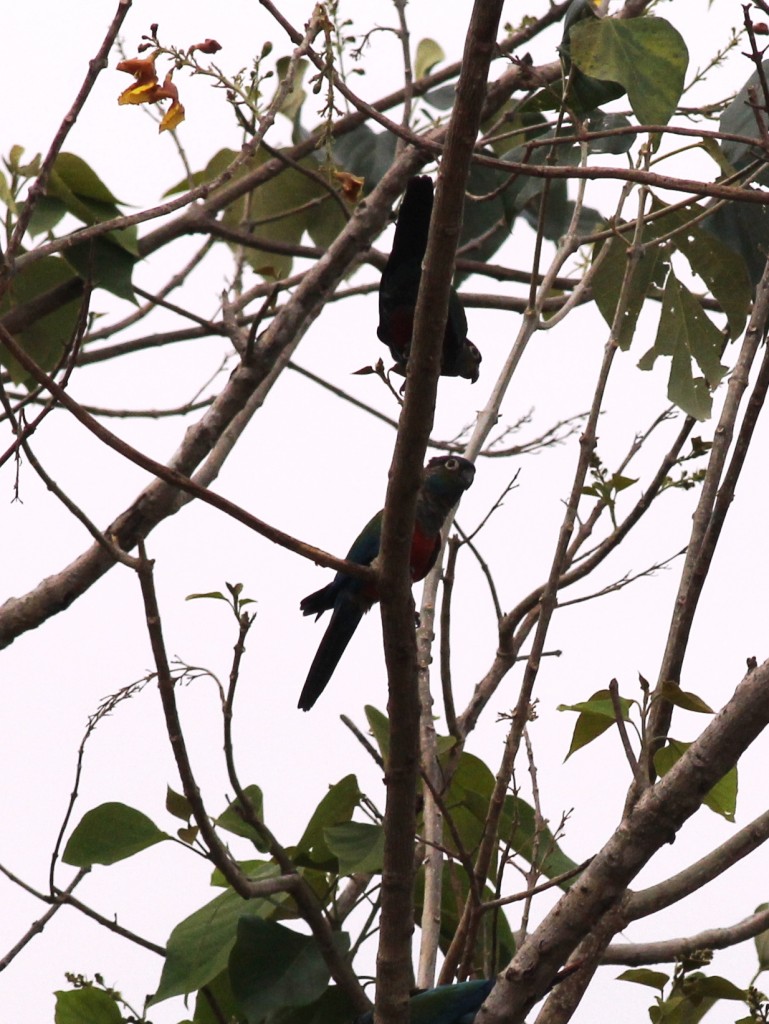This will be a reference post I use often when analyzing the lodges in any particular area. While I will only do a REVIEW of a lodge I have actually been to, I will use other resources found online to determine the lodging options in any avian eco-tourism adventure.
There are several things to consider when choosing an eco-lodge. In some cases, you will be choosing a location because of a bird species you want to see which may have only a small range. An example of this is Crimson-bellied Conures (Pyrrhura perlata), which are only found in the central and south Amazon basin. The only eco-lodge in their habitat is Cristalino Jungle Lodge based in Alta Foresta, Brazil. So in this case, the lodge is chosen for you by the species.

Crimson-Bellied Conures
In other cases such as Scarlet Macaws (Ara macao), they can be found all over South and Central America so you have many choices. Even in cases such as Tambopata National Reserve, the Pantanal, Carara National Park you will have many different lodges to choose from in the same area. So how should you choose?
CONTRIBUTION TO CONSERVATION
Is the lodge affiliated with a conservation project? Do they sponsor scientific research? Do they have an education program for foreign volunteers and local employees? Do they make an effort to be sustainable and “Green”? Do they have a program to protect wildlife from poachers? Do they train former poachers to be guides? Do they financially support any conservation causes?
LOCATION
Are they in the reserve or park, or in a town nearby? How do you get there? Can you drive in yourself? Do you have to use their transport if it is a remote location? Can you afford the transportation to get there? Are the local people actively involved with the lodge?
SPECIES OF BIRDS AND ANIMALS
Is there a bird list and animal list on their website? Which lodge reports more sightings of the species that interest you? Are the species easily found?
SIZE, ROOMS AND CLIENTELE
How large is the lodge? Is it so big that it will feel crowded? Is it too small that you worry about the level of service? Do they prepare their own meals or do you have to self-cater? Do they accept children as guests? Are you looking for opportunities to socialize or to get away from people and be with nature? Do they have separate bungalows or motel-style accommodation? Does the lodge blend in with the environment?
IN-HOUSE GUIDES
If you are not part of a pre-organized group, you will be using the in-house guides and probably put into small groups with other guests. Where do the guides come from? Who trains them? How well do they know the bird calls? Do they know the habitat well and likely places to find birds?
COST
What options of accommodation do they offer? Do they have a dorm for backpackers? Do they have family accommodation? Do they include meals? What other extras are included in the package (guided walks, boat trips, photography instruction, etc)? Are there seasonal rates? Group discounts? How do you pay? How much in advance? Do they take credit card on a secure serve? Paypal? Is the only way to pay via bank transfer (which has fees involved)? Can you use a portal such as Expedia, Hotels.com, Booking.com? What is the cancellation or rebooking policy if your plans change? Do they take credit cards for incidentals or will you have to bring cash along?
ONLINE REVIEWS
What do other people say about them on Trip Advisor, Lonely Planet, Facebook and birding sites such as Surfbirds, Fat Birder, etc? What do people like? What do they not like? Does the lodge manager communicate on social media and seems like they want people to be happy?
YOUR PRIORITIES
You are unlikely to find one lodge that has everything you want so you will have to know what is most important to you. The species you want may only be found at a small, remote lodge that is expensive to get to and stay at. You may have to take a long trip down the river in a small boat which some people may find uncomfortable. The menu may be limited at remote lodges and you may end up being the only ones there in the off-season. One lodge may be in your budget but it may be a larger one and more crowded. A lodge that accepts families may have you waking to screaming kids instead of warbling birds. You can never do too much research when it comes to choosing an eco-lodge!

